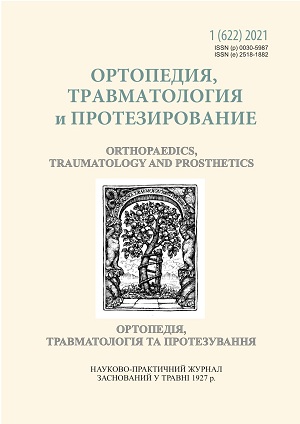Violation of consolidation of the femur after untimely dynamization of the intramedullary blocking rod
DOI:
https://doi.org/10.15674/0030-59872021169-72Keywords:
blocked intramedullary osteosynthesis, disorders consolidation, dynamization of the constructionAbstract
Violation of femoral fracture consolidation after blocking intramedullary osteosynthesis is a fairly common pathology, and requires the attention of physicians due to its prevalence. There are several reasons for this complication: it is the instability in the system «bone-implant», and the untimely dynamization of the locking nail. Methods. This article presents a case of fracture violated consolidation after blocking intramedullary osteosynthesis caused a nonunion due to nail failure. Results. Patient was injured on 29.12.2018, as a result of a traffic accident. 01.15.2019, the surgery was performed: closed reduction, blocking intramedullary osteosynthesis of the fracture of the middle shaft of the right thigh, static fixation of the nail. Next visit to the clinic was on 02.01.2020, because of pain in the middle third of the thigh, problems with axial weight-bearing on the right leg, limitation of the flexion in the right knee joint. Control radiographs demonstrated no signs of consolidation of the femoral shaft fracture, and migration of the distal locking screw. 08.01.2020 revision surgical treatment was performed. Given the presence of 5 mutually perpendicular holes in the distal part of the nail, two of them were locked in the anterio-posterior view by the free hand method, the migrated screw in the distal part of the nail was replaced, and the nail was dynamized in the proximal part taking into account its design features. Conclusions. To normalize the consolidation processes in patients with nonunion femoral fractures, bone physiology and the positive effect of autocompression should be considered. The described case demonstrates the necessity for timely dynamization of the blocking nail, which confirms our own observations and literature data. Despite the fact that the dynamization of the nail was performed 1 year after blocking intramedullary osteosynthesis, fracture consolidation occurred 5 months after its implementation. Key words. Femoral fracture, blocked intramedullary osteosynthesis, disorders consolidation, dynamization of the construction.
References
- Ricci, W. M., Gallagher, B., & Haidukewych, G. J. (2009). Intramedullary nailing of femoral shaft fractures: Current concepts. Journal of the American Academy of Orthopaedic Surgeons, 17(5), 296-305. https://doi.org/10.5435/00124635-200905000-00004
- Swanson, E. A., Garrard, E. C., Bernstein, D. T., O'Connor, D. P., & Brinker, M. R. (2015). Results of a systematic approach to exchange nailing for the treatment of aseptic femoral Nonunions. Journal of Orthopaedic Trauma, 29(1), 21-27. https://doi.org/10.1097/bot.0000000000000166
- El Moumni, M., Leenhouts, P., Ten Duis, H., & Wendt, K. (2009). The incidence of non-union following unreamed intramedullary nailing of femoral shaft fractures. Injury, 40(2), 205-208. https://doi.org/10.1016/j.injury.2008.06.022
- Rublenik, I. M., Vasyuk, V. L., & Kovalchuk, P. E. (2011). 30-year experience of using blocking intramedullary metallopolymer osteosynthesis in the treatment of long bone fractures in 1200 patients. Bulletin of the All-Russian Scientific Center of the Siberian Branch of the Russian Academy of Medical Sciences, 4(80), 162. [in Russian]
- Vaughn, J., Gotha, H., Cohen, E., Fantry, A. J., Feller, R. J., Van Meter, J., Hayda, R., & Born, C. T. (2016). Nail Dynamization for delayed union and Nonunion in femur and tibia fractures. Orthopedics, 39(6), e1117-e1123. https://doi.org/10.3928/01477447-20160819-01
- Perumal, R., Shankar, V., Basha, R., Jayaramaraju, D., & Rajasekaran, S. (2018). Is nail dynamization beneficial after twelve weeks – An analysis of 37 cases. Journal of Clinical Orthopaedics and Trauma, 9(4), 322-326. https://doi.org/10.1016/j.jcot.2017.12.007
- Vicenti, G., Bizzoca, D., Carrozzo, M., Nappi, V., Rifino, F., Solarino, G., & Moretti, B. (2018). The ideal timing for nail dynamization in femoral shaft delayed union and non-union. International Orthopaedics, 43(1), 217-222. https://doi.org/10.1007/s00264-018-4129-y
- Klymovytsky, V. G., Chernysh, V. Yu., & Borzykh, O. V. Unfused fractures and pseudoarthrosis. http://www.mif-ua.com/education/symposium/perelomi-scho-nezroslisya-ta-psevdoartrozi. [in Ukrainian]
- Balakina, V. S. (1973). False joints of long tubular bones and their treatment. Orthopedics, Traumatology and Prosthetics, 3, 9-14. [in Russian]
- Romanenko, K. K. (2002). Non-accrete diaphyseal fractures of long bones (risk factors, diagnosis, treatment). [Unpublished PhD dissertation]. [in Russian]
- Somford, M. P., Kloen, P., & Van den Bekerom, M. P. (2013). Operative treatment for femoral shaft nonunions, a systematic review of the literature. Strategies in Trauma and Limb Reconstruction, 8(2), 77-88. https://doi.org/10.1007/s11751-013-0168-5
- Maqungo, S., Horn, A., Bernstein, B., Keel, M., & Roche, S. (2014). Distal interlocking screw placement in the femur. Journal of Orthopaedic Trauma, 28(12), e281-e283. https://doi.org/10.1097/bot.0000000000000125
Downloads
How to Cite
Issue
Section
License

This work is licensed under a Creative Commons Attribution 4.0 International License.
The authors retain the right of authorship of their manuscript and pass the journal the right of the first publication of this article, which automatically become available from the date of publication under the terms of Creative Commons Attribution License, which allows others to freely distribute the published manuscript with mandatory linking to authors of the original research and the first publication of this one in this journal.
Authors have the right to enter into a separate supplemental agreement on the additional non-exclusive distribution of manuscript in the form in which it was published by the journal (i.e. to put work in electronic storage of an institution or publish as a part of the book) while maintaining the reference to the first publication of the manuscript in this journal.
The editorial policy of the journal allows authors and encourages manuscript accommodation online (i.e. in storage of an institution or on the personal websites) as before submission of the manuscript to the editorial office, and during its editorial processing because it contributes to productive scientific discussion and positively affects the efficiency and dynamics of the published manuscript citation (see The Effect of Open Access).














